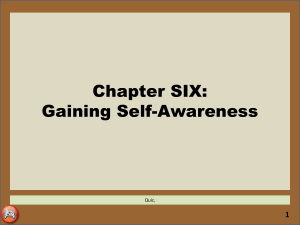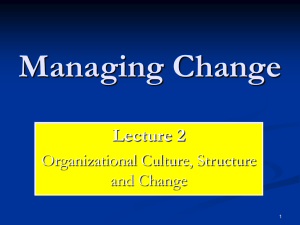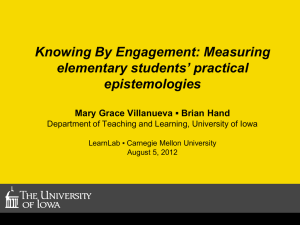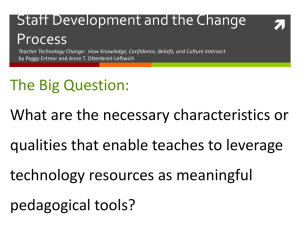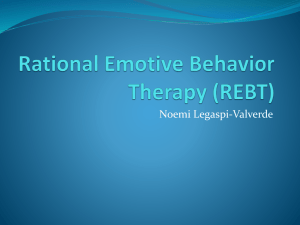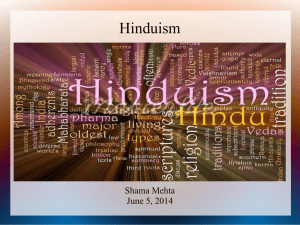HOC 1 - 6 Cultural Diversity
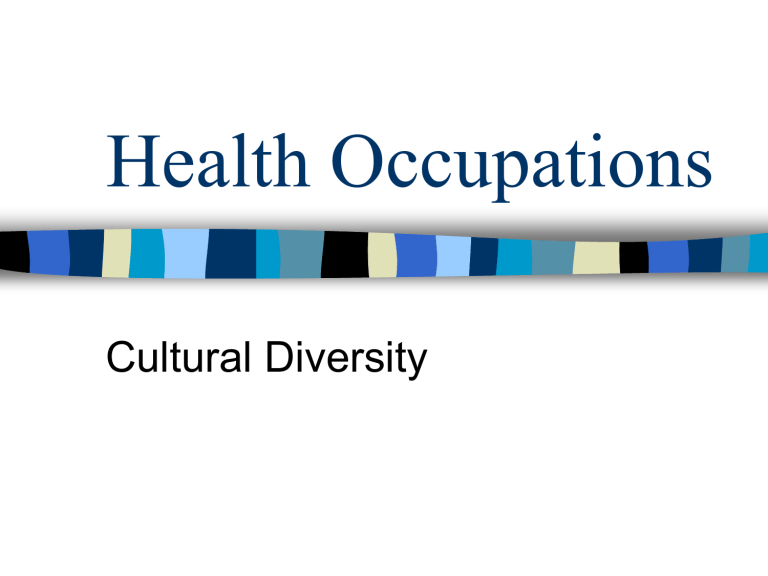
Health Occupations
Cultural Diversity
Individual factors causing uniqueness
Physical characteristics:
– Gender
– Body size
– Hair, nail, skin color
Family life
Socioeconomic status
Religious beliefs
Geographical location
Education & occupation
Life experiences
Cultural/ethnic heritage
Culture
Definition – values, beliefs, attitudes, languages, symbols, rituals, behaviors, & customs unique to a particular group of people & is passed down from one generation to the next
Set of rules
– Blueprint for living
– Family relation, child rearing, education, occupational choice, social interactions, spirituality, religious beliefs, food preferences, health beliefs, & health care
Culture
Not uniform through-out group but does provide foundation for behavior
4 basic characteristics
– Culture is learned
– Culture is shared
– Culture is social in nature
– Culture is dynamic & changing
Ethnicity
Classification of people based on national origin &/or culture
– Share common heritage, national origin, social customs, language, & beliefs
– May not practice all cultural beliefs but is still influenced by members of group
Common ethnic groups in U.S.
– African American, Asian American, European
American, Hispanic American, Middle
Eastern/Arabic American, Native American
– Subgroups within each ethnic group
Race
Classification of people based on physical or biological characteristics
– Color of skin, hair, & eyes
– Facial features
– Blood type
– Bone structure
Frequently used to LABEL people & explain patterns of behavior
Race cuts across multiple ethnic/cultural groups, it is the values from the groups than account for behaviors (White & black
Africans, Hispanics, & Asians)
Cultural Diversity
Differences among people resulting from cultural, ethnic, & racial factors
– Influence behavior, self-perception, judgment of others, & interpersonal relationships
“Melting pot” – absorption of other cultures into the dominant culture – ASSIMILATION
“Salad bowl” – cultural differences are appreciated & respected, multicultural society
Cultural diversity
Acculturation
– Process of learning the beliefs & behaviors of a dominant culture & assuming some of the characteristics
– Occurs slowly over time, usually years
• Recent immigrants are more likely to follow the language
& customs of the country from which they immigrated
• Second & third generation Americans are more likely to use English & follow American behavior patterns
– HCP must be aware of cultural diversity & know that no person is 100% anything
• Sensitivity – ability to recognize & appreciate the personal characteristics of others is important (ex. Calling patients by their first name may be seen as disrespectful)
Bias interferes with cultural diversity
A preference inhibiting impartial judgment
Ethnocentricity – believing that your ethnic group is superior to others
– May antagonize others from different cultures
Common biases
– Young people physically/mentally superior
– College educated people superior
– Rich people superior to poor people
– Obese & short people inferior
– Nurses inferior to doctors
– Women inferior to men
– Sexual preference can also have bias
Prejudice interferes
Strong feeling or belief about a person or subject formed without reviewing facts or information, “pre-judge”
Prejudiced people regard their ideas as right
& other ideas as wrong
Afraid of things that are different
Causes fear & distrust, interfering with interpersonal relationships
All people prejudiced to some degree
– Want to feel that our beliefs are correct
– Obtain as much info as possible to decrease prejudice
Stereotyping interferes
Assumption that everyone in a particular group is the same
Ignores individual characteristics & labels an individual
– “All blondes are dumb”
– “All jocks are stupid”
– Exists regarding race, gender, body size, occupation, & ethnic/cultural groups
Avoiding bias, prejudice, & stereotyping
These are barriers to effective relationships
Ways to avoid
– Know & be aware of own beliefs & values
– Learn about other groups
– Be sensitive to behaviors/practices different than yours
– Respect others’ beliefs, don’t have to practice them
– Develop friendships with wide variety of people
– Ask & encourage questions
– Evaluate all info before forming opinion
– Be open about differences, avoid jokes
– If mistakes happen, apologize or forgive
Areas of cultural diversity
Goal is to provide holistic care – wellbeing of the entire person, physical, social, emotional,
& mental needs
Family organization – structure of family & who is dominant
– Nuclear family – mom, dad, children
• Extended family important
• European Americans
– Extended family – nuclear + grandparents, aunts, uncles, cousins
• Many generations share same household
• Asian, Hispanic, & Native Americans
Areas of cultural diversity
Family organization (cont)
– Affects care of children, sick, & elderly
• Nuclear families – people outside of family care for children, sick, elderly
• Extended families – families take care of children, sick, elderly within the home
– Patriarchal – father or oldest male in charge
– Matriarchal – mother or oldest female in charge
– Many families have both mother & father sharing responsibility
Areas of cultural diversity
Family organization (cont)
– Pts with extended families may have many visitors with everyone concerned & with an opinion
– Family members may provide personal cares
– Allow family to assist as much as possible
– Ask questions to determine which type of family the pt has & what they are comfortable with
Areas of cultural diversity
Language
– Dominant language – English
– Many other languages are spoken (20% of population under age 65)
– Variations within a language
– Translators helpful
– Points to follow with non-English speakers
• Speak slowly
• Use simple words & nonverbal communication
• Use gestures or pictures
• Don’t speak louder than normal
• Learn words or phrases in pt’s language
• Legal requirements – informed consent
Areas of cultural diversity
Personal space & touch
– Territorial space – distance people require to feel comfortable while interacting with others
– Close-contact cultures
• Comfortable standing close to & touching
• Arabs, French, Latin Americans, Hispanic Americans
• Within cultural groups, variations
– Women stand closer than men
– Children stand closer than adults
– Distant-contact cultures
• Prefer space (2-6 ft) during interactions
– African & European Americans like space, but will shake hands
Areas of cultural diversity
Personal space & touch (cont)
– Asian Americans stand closer but usually don’t touch, no PDA
– Cambodia – opposite sexes may never touch in public, only parents can touch head of child
– Vietnamese – only elders can touch children’s heads (head is sacred)
– Middle Eastern countries – men may not touch unrelated females, men can shake hands only with men
Areas of cultural diversity
Personal space & touch (cont)
– HCP have to use touch & invade personal space to give care
• Use slow & relaxed approach, give pt time
• Be alert to verbal & nonverbal
• Give pt breathing room, move in & out
• Determine preferences by asking questions
Areas of cultural diversity
Eye contact
– European Americans – interest & trustworthiness
– Asian Americans my consider it rude
– Native Americans use peripheral vision, may regard as hostile or threatening
– Hispanic & African Americans may use brief eye contact but then look away to indicate respect & attentiveness
– Muslim women – avoid as sign of modesty
– India – people of different socioeconomic classes avoid eye contact with each other
Areas of cultural diversity
Eye contact (cont)
– Different beliefs can lead to misunderstandings
– Be alert to comfort levels
• Lack of eye contact may be respect instead of not listening
Areas of cultural diversity
Gestures
– U.S. gestures for yes & no are actually opposite in
India
– Pointing at someone is common in U.S. but a threat among some Native Americans & Asians
– O.K. sign is insulting to some Asian cultures
– Be aware that gestures may be misinterpreted & avoid if pts are uncomfortable with them
Areas of cultural diversity
Health Care Beliefs
– Biomedical health care system
• Most common health care system in U.S.
• Western system
• Cause of disease = microorganisms, diseased cells, & aging
• Licensed practitioners
• Beliefs
– Encourage pts to learn about illness
– Inform pts about terminal disease
– Teach self-care
– Uses medications & techniques to cure
– Teaches preventive care
Areas of cultural diversity
Alternative health care methods
– Can be used in addition to or as replacement for biomedical health care
– Chiropractors, homeopaths, naturopaths, hypnotists
– Types of treatments
• Nutritional methods – organic foods, herbs, vitamins, antioxidants
• Mind & body control methods- relaxation, meditation, biofeedback, hypnotherapy, imagery
• Energetic touch therapy – massage, acupuncture, accupressure, therapeutic touch
• Body-movement methods – yoga, tai chi, chiropractors
• Spiritual methods – faith healing, prayer, spiritual counseling
Areas of cultural diversity
Spirituality
– Beliefs individuals have about themselves, their connections with others, & relationships with a higher power
– Need to find meaning & purpose in life
– With strong foundation, has basis for understanding life, finding support, & drawing on resources to deal with problems
– Can be expressed through religious practices but are two different things
– Evolves & changes throughout life
Areas of cultural diversity
Religion
– Organized system of belief in a superhuman power or higher power
– Associated with a particular church
– Beliefs about birth, life, illness, & death have religious origins
– Can affect dietary practices
– Pts may not follow all customs & beliefs of their religion
– Atheist – person who does not believe in any deity
– Agnostic – person who believes that the existence of God cannot be proved or disproved
Areas of cultural diversity
Religion (cont)
– Show respect by
• Be a willing listener
• Provide support for religious practices
• Respect symbols & books
• Allow privacy during clergy visits or while pt is observing religious customs like communion, prayer, & meditation
• Refrain from imposing your own beliefs on the pt
Respecting cultural diversity
Regard each person as unique individual
Recognize that every person adopts beliefs & forms patterns of behaviors based on culture, ethnicity, life experiences, spirituality, & religion
Be aware of pts needs to provide total care (holistic)
Respecting cultural diversity
Learn to appreciate & respect the personal characteristics of others
– Listen to pts express their beliefs
– Learn to appreciate differences
– Learn more about different groups
– Recognize & avoid bias, prejudice, & stereotyping
– Ask questions to determine pts’ beliefs
– Allow pts to practice beliefs if possible
– Be sensitive to pts reactions to eye contact, touch, invasion of personal space
– Respect spirituality, religion, symbols, & rituals

